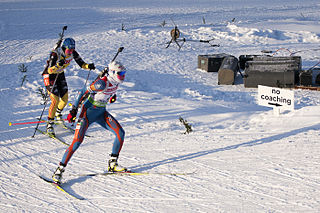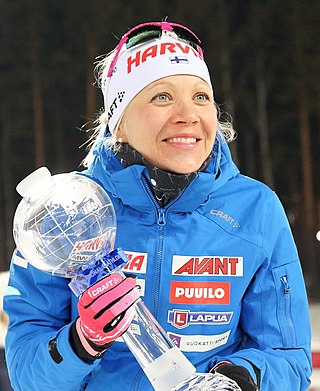
The first Biathlon World Championships (BWCH) was held in 1958, with individual and team contests for men. The original team event, Team (time), was held for the last time in 1965, to be replaced in 1966 by the team event, Relay, which we know today. The number of events has grown significantly over the years. Beginning in 1984, women biathletes had their own World Championships, and finally, from 1989, both genders have been participating in joint Biathlon World Championships. In 1978 the development was enhanced by the change from the large army rifle calibre to a small bore rifle, while the range to the target was reduced from 150 to 50 meters.

Magdalena "Magda" Forsberg is a Swedish former cross-country skier and biathlete. She was the dominating female biathlete from 1997 to 2002, when she retired, winning the Biathlon World Cup for six years straight. She is also a six-times world champion, a two-times Olympic bronze medalist, and holds the record for the most World Cup victories in women's biathlon.

Kikkan Randall is an American Olympic champion cross-country skier. She has won 17 U.S. National titles, made 29 podiums on the World Cup, made five trips to the Winter Olympic Games and had the highest finish by an individual American woman at the World Championships, second in the Sprint in Liberec in 2009. She was the first American female cross-country skier to take a top ten finish in World Cup competition, to win a World Cup race and to win a World Cup discipline title. She won the silver medal in the individual sprint at the FIS Nordic World Ski Championships 2009 in Liberec, becoming the first American woman to win a medal in cross country skiing at the FIS Nordic World Ski Championships, and in 2013 teamed up with Jessie Diggins to win the first ever American FIS Nordic World Ski Championships gold medal in the team sprint. She and Diggins won the United States' first ever cross-country skiing gold medal at the Winter Olympics in women's team sprint at Pyeongchang in 2018.

Tésero is a comune (municipality) in Trentino in the northern Italian region Trentino-Alto Adige/Südtirol, located in the Val di Fiemme about 40 kilometres (25 mi) northeast of Trento.
Kaisa Varis is a Finnish retired cross-country skier and biathlete. Her career has been marred by doping convictions: as a cross-country skier, she was involved but not suspended in a doping scandal and in 2003 she was suspended two years for doping use. After her suspension, she returned as a biathlete in 2007, but in 2008 she received a lifetime ban from all International Biathlon Union (IBU) competitions after another positive doping test. However, her lifetime ban was overturned in March 2009 because the Court of Arbitration for Sport ruled that the IBU failed to adhere to correct testing procedures; she remains eligible to compete in biathlon.
Sport is considered a national pastime in Finland and many Finns visit different sporting events regularly. Pesäpallo is the national sport of Finland, although the most popular forms of sport in terms of television viewers and media coverage are ice hockey and Formula One. In spectator attendance, harness racing comes right after ice hockey in popularity.

Birkebeineren Ski Stadium is a cross-country skiing and biathlon venue located in Lillehammer, Norway. Situated 3 kilometers (2 mi) from the town center and at 485 meters (1,591 ft) above mean sea level, it has two stadium areas, one for cross-country and one for biathlon. The former has a capacity for 31,000 spectators, and the latter for 13,500. The venue was built for the 1994 Winter Olympics, costing 83.6 million Norwegian krone (NOK). It was subsequently used by the 1994 Winter Paralympics for Paralympic Nordic skiing and Paralympic biathlon. After the games, ownership was transferred to the municipal Lillehammer Olympiapark. The venue has since been used for one Biathlon World Cup, three FIS Cross-Country World Cup and nine FIS Nordic Combined World Cup tournaments, the latter with the ski jumping competition taking place at the nearby Lysgårdsbakkene Ski Jumping Arena. Birkebeineren hosted the 2016 Winter Youth Olympics.

Kaisa Leena Mäkäräinen is a Finnish former world-champion and 3-time world-cup-winning biathlete, who currently competes for Kontiolahden Urheilijat. Outside sports, Mäkäräinen is currently studying to be a Physics teacher at the University of Eastern Finland in Joensuu. Her team coach is Jonne Kähkönen, while Jarmo Punkkinen is her ski coach.

Miriam Neureuther is a former German biathlete and cross-country skier. She has won an Olympic silver medal in cross-country skiing and two biathlon world championship titles, all in team events. Noted for her fast skiing performances, she won two junior world championship titles in biathlon in 2008 and 2009. Gössner was called up for the Nordic World Ski Championships 2009, where she was part of Germany's cross-country team claiming silver in the 4 × 5 kilometre relay.

The 1994 Winter Olympics were held in and around Lillehammer, Norway, from 12 to 27 February 1994. Ten competition and fourteen non-competition venues were used, most of which were subsequently used for the 1994 Winter Paralympics. The Games were spread out over ten venues in five municipalities in two counties, Oppland and Hedmark. Lillehammer, with approximately 25,000 inhabitants, and Hamar and Gjøvik, both with approximately 27,000 inhabitants, are all situated on the lake Mjøsa. Gjøvik and Hamar are 45 and 54 kilometers south of Lillehammer, respectively. Hunderfossen is 15 kilometers (9.3 mi) north of Lillehammer, but located within the municipality. Øyer and Ringebu, each with just under 5,000 inhabitants, are 18 and 50 kilometers north of Lillehammer, respectively, in the valley Gudbrandsdalen. Lillehammer had four competition venues, Hamar had two competition venues, while Hunderfossen, Gjøvik, Øyer and Ringebu had one competition venue each.
For the 1924 Winter Olympics in Chamonix, France, a total of three sports venues were used. The main stadium was used for all but two sports and part of a third. It was the first ski jump used for the Winter Olympics. A bobsleigh track was prepared for use.
For the 1960 Winter Olympics in Squaw Valley, California, in the United States, a total of five sports venues were used. Except for the Palisades Tahoe, all of the venues had to be constructed. For the first time in Winter Olympic history, a temporary venue was constructed at McKinney Creek for biathlon, cross-country skiing, and Nordic combined. A bobsleigh track was not constructed over the guarantees from the FIBT not being able to field the minimum twelve teams needed to compete, making it the only time bobsleigh has not been included in the Winter Olympics.

For the 1980 Winter Olympics in Lake Placid, New York, United States, a total of seven sports venues were used. All five of the venues used for the 1932 Winter Olympics were also used at the 1980 Winter Games with adjustments. These adjustments included electronic scoreboards, increased refrigeration, and the addition of a separate luge track. This was the last Winter Olympics where there were separate bobsleigh and luge tracks. The closest finish in Olympic history in cross-country skiing led skiing officials to time future events in hundredths of a second rather than tenths of a second. This would also apply to biathlon events. Eric Heiden won five gold medals at the speed skating oval while the "Miracle on Ice" took place between Americans and Soviets at the Olympic Center. In the late 1990s, the luge track was demolished and a new combination track was constructed in time for the only Winter Goodwill Games held. The sliding venue was named to the American National Register of Historical Places in February 2010.

Holmenkollen National Arena is a Nordic skiing, ski jumping and biathlon venue located at Holmenkollen in Oslo, Norway. It consists of the large ski jumping hill Holmenkollbakken, the normal hill Midtstubakken and a stadium for cross-country skiing and a shooting range for biathlon. Since 1892, it has hosted the annual Holmenkollen Ski Festival, which is part of the world cup tournaments in ski jumping, cross-country skiing, Nordic combined, as well as annual Biathlon World Cup races. It has previously hosted the 1952 Winter Olympics, and the FIS Nordic World Ski Championships in 1930, 1966, 1982 and 2011.
Biathlon Junior World Championships were first held in 1967 for men and in 1984 for women. According to the International Biathlon Union rules, biathletes qualify as Junior if they turn 20, 21 or 22 during the season from November to October, they qualify as Youth when they turn 17, 18 or 19 during the season.

Stina Nilsson is a Swedish former biathlete and former cross-country skier. She is a five-time Olympic medalist and the 2018 Olympic champion in the individual sprint. In March 2020 she announced that she would switch to competing in biathlon. In April 2024, she announced her return to cross-country skiing, this time as a long-distance racer.

Mari Eder is a Finnish former biathlete and cross-country skier.

Competitive cross-country skiing encompasses a variety of race formats and course lengths. Rules of cross-country skiing are sanctioned by the International Ski Federation and by various national organizations. International competitions include the FIS Nordic World Ski Championships, the FIS Cross-Country World Cup, and at the Winter Olympic Games. Such races occur over homologated, groomed courses designed to support classic (in-track) and freestyle events, where the skiers may employ skate skiing. It also encompasses cross-country ski marathon events, sanctioned by the Worldloppet Ski Federation, and cross-country ski orienteering events, sanctioned by the International Orienteering Federation. Related forms of competition are biathlon, where competitors race on cross-country skis and stop to shoot at targets with rifles, and paralympic cross-country skiing that allows athletes with disabilities to compete at cross-country skiing with adaptive equipment.

The Swedish Ski Games is an annual cross-country skiing event in Sweden. The games started in Sundsvall in 1947 but moved to Falun in 1959. Up to 1991, ski jumping and Nordic combined skiing were also included as a recurring event. Included were also alpine skiing between 1950–1953 and biathlon in 1984. Since 1992, the Swedish Ski Games has arranged international cross-country skiing events only. The event is usually held in February–March as one of the final World Cup competitions during the season. The event is usually held at Lugnet. Lack of snow has sometimes required the event to be moved to other places.

The Cross country and biathlon center Fabio Canàl, until December 2018 named Lago di Tésero Cross Country Stadium is a sport venue located in the village of Lago, in the municipality of Tésero, in Trentino, northern Italy. It will host cross-country skiing and nordic combined for the 2026 Winter Olympics and Paralympics.




















